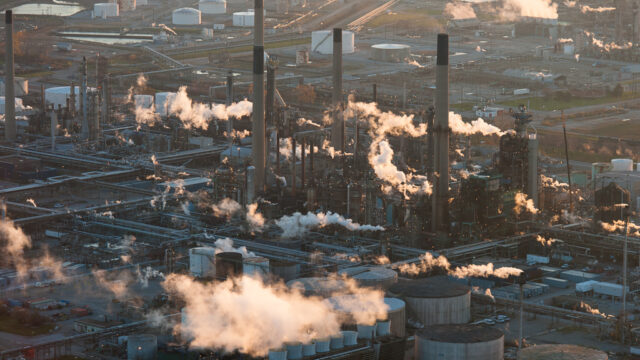Nearly 43 years after first introducing its SO2 standard, the government has taken an important step to modernize it
For years, Ecojustice has pushed Ontario’s Ministry of the Environment and Climate Change to strengthen its wildly outdated air quality standard for sulphur dioxide (SO2). That’s why we’re celebrating an important victory. This month, the Ministry adopted a new standard that significantly lowers the level of SO2 any industrial facility can legally release into the air. The new standard is nearly seven times lower, limiting the maximum hourly concentration of SO2 from any facility to 100 µg/m3 down from 690 µg/m3.
Elevated concentrations of SO2 are known to cause respiratory distress, particularly in vulnerable populations including children, seniors and people with asthma. Exposures for as little as ten minutes can cause coughing, wheezing and shortness of breath. SO2 has also been linked to cardiovascular distress and is suspected to be linked to reproductive and developmental health impacts.
We have witnessed first-hand the devastating impacts that SO2 pollution can have on a community and its residents, having worked for more than a decade with residents of the Aamjiwnaang First Nation in Sarnia. This community is surrounded by an area known as Chemical Valley — a cluster of heavy industry, including petroleum refineries, petrochemical manufacturing plants, and power plants.
Ontario’s previous standard was set in the 1970s, and was overdue for an overhaul. Ontario itself admitted that that standard did not protect the health of people most vulnerable to the impacts of SO2 pollution — including people with asthma and children. Ontario’s new standard should protect those people, as well as the rest of Ontarians.
Along with the new SO2 standard, Ontario has changed the rules governing how industrial facilities must report SO2 (and other pollutant) levels during non-standard operating conditions, such as when a facility is starting up, shutting down, or experiencing equipment malfunction. In many cases, the highest pollution emissions occur during these times, when facilities often operate their flares to burn off gases.
By default, industrial air pollution is illegal in Ontario. To release contaminants into the air, an industrial facility must get an approval from the Ministry. The Ministry can only give out such an approval if the facility demonstrates that it will meet applicable air standards. In order to demonstrate compliance, industrial facilities are supposed to estimate pollution levels under a wide range of operating conditions — including a worst case scenario.
Unfortunately, some facilities’ estimates do not always reflect pollution levels during start-ups and shutdowns, or during other flaring events. For example, in communities like Sarnia, petroleum refineries sometimes burn acid gas composed of hydrogen sulphide (H2S) in their flares. When a plant burns off acid gas, the H2S is converted to SO2. Depending on how much acid gas is flared, this could result in high spikes of SO2 pollution. Yet some refineries have not been considering the SO2 emissions that occur from acid gas flaring in their estimates to the Ministry. This has created a situation where some facilities may be approved to operate without fully considering their pollution impacts and the resulting health risks for those living nearby.
The government has introduced new rules to clarify that all industrial facilities have to consider start-up and shutdown emissions, in addition to their normal operating emissions, when estimating pollution levels for the Ministry. The Ministry has also clarified that petroleum refineries must consider acid gas flaring emissions when estimating pollution levels.
Under the previous rules, facilities had to consider the worst-case operating scenario when estimating their emissions — a scenario that might be broader than the more specific scenarios the new rules will require a facility to consider. But while we believe these changes therefore narrow the previous requirement, we also believe that they will clarify the rules and eliminate perceived loopholes so that industry can no longer avoid considering pollution levels from these high-emission scenarios.
So, while on paper the changes weaken the regulation, we hope that they lead to on-the-ground improvements in air quality by forcing the industry to more accurately estimate pollution levels. For example, if estimating pollution levels more accurately shows that a facility emits SO2 at levels that exceed the old standard, industry and the Ministry would need to take steps to reduce pollution levels to the legal limit — which would lead to some air quality improvement even before the new standard comes into force.
Although the SO2 standard update is long overdue, it will not become legally binding until 2023. Even with air quality improvements driven by new rules about accurately estimating emissions, this delay means that SO2 pollution will continue to disproportionately impact vulnerable populations.
At the same time, the Ministry has excluded SO2 from its proposed new policy for managing the cumulative effects of air pollution. This would allow the combined emissions from facilities to exceed the standard, even if each facility individually complies — and leave communities with several large SO2 emitters to continue to be disproportionately impacted by SO2 emissions.
Once implemented, the new SO2 standard should help protect the health of all Ontarians, including children and people with asthma, who are most at risk from exposure. But we have a long way to go before our air pollution laws protect our basic human right to a healthy environment, including air that is safe to breathe.
While clean air is something many of us take for granted, there are still far too many communities in Ontario for whom it is still not a reality. We’re hopeful that the Ministry’s update means Ontario is one step closer to making clean, safe air a possibility for all communities across the province.





